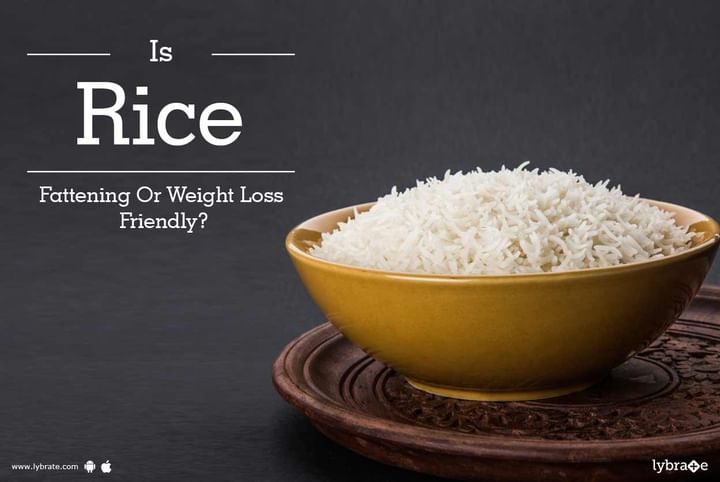Is Rice Fattening Or Weight Loss Friendly?
Rice is one of the most widely consumed grains in the world. It’s mostly comprised of simple carbs, which have consistently been linked to obesity and chronic disease. However, countries with a high rice intake have low levels of these exact diseases. So what’s the deal with rice? Is it weight loss friendly or fattening? This article gets to the bottom of this question.
What Is Rice?
Rice is a cereal grain that has been grown for thousands of years. It’s a staple food in many countries and one of the most common cereal grains in the world. Several types are available, but varieties of white rice are the most popular, followed by brown rice. To better understand these different types, it’s best to start with the basics.
All whole grains are composed of three major components:
- Bran: A rough and hard outer layer that protects the seed. It contains fibre, minerals and antioxidants.
- Germ: A nutrient-rich core containing carbs, fat, protein, vitamins, minerals, antioxidants and other plant compounds.
- Endosperm: This is the largest part of the grain. It consists almost entirely of carbs (starch) and a small amount of protein.
Brown rice is an intact whole grain that contains both the bran and germ. Therefore, it’s nutritious and rich in fibre and antioxidants. On the contrary, white rice has had both the bran and nutritious germ removed, ultimately stripping it of all its nutritional parts. This is generally done to improve its taste, prolong its shelf life and enhance its cooking qualities. As a result, white rice varieties are almost entirely made up of carbs in the form of starches, or long chains of glucose known as amylose and amylopectin. Different types of rice contain different amounts of these starches, which affects their texture and digestibility.
Rice that does not stick together after cooking is high in amylose, while sticky rice is generally high in amylopectin. Because of these variations in starch composition, different types of rice can have different health effects.
Brown Versus White Rice
Since nothing has been stripped from brown rice it is generally higher in fibre, vitamins and minerals than white rice. The table below compares the nutrient contents of 100 grams of cooked white and brown rice.
| White v/s. Brown Rice | White | Brown |
| Calories | 130 | 112 |
| Carbs | 29 grams | 24 grams |
| Fiber | 0 grams | 2 grams |
| Protein | 2 grams | 2 grams |
| Fat | 0 grams | 1 gram |
| Manganese | 19% RDI | 55% RDI |
| Magnesium | 3% RDI | 11% RDI |
| Phosphorus | 4% RDI | 8% RDI |
| Vitamin B6 | 3% RDI | 11% RDI |
| Selenium | 11% RDI | 14% RDI |
White rice is higher in calories and contains fewer nutrients and fibre than brown rice.
Rice Is a Staple Food in Many Countries
Rice is a staple food for more than half of the world’s population, particularly Asian countries like China, Japan, Korea and India. These are all countries that, until recently, had relatively low percentages of people who were overweight or obese. White rice is the predominant source of carbohydrates in those countries. For example, Koreans consume almost 40% of their total calorie intake from rice. In these countries, rice may be consumed an average of 20 times per week and up to six times per day. Even so, rice consumption seems to protect against weight gain and high blood pressure in these populations. In elderly Chinese people, a dietary pattern high in rice and vegetables seems to help prevent weight gain, large waist circumference and obesity. The same results were found in a study including over 200 overweight Iranians. No association between the frequency of white rice consumption and body mass index or belly fat was found. However, this trend may be changing, as diets in these countries become influenced by the Western Diet. In fact, the numbers of overweight and obese people have skyrocketed in many of these countries in the past few years.
One study among Iranian adolescents showed that those who had the highest rice intake had the worst diet quality. This indicates that these adolescents may be consuming rice with foods that older generations did not eat, potentially leading to weight gain. At this point, it seems that rice intake itself has a neutral effect, while its health effects — positive or negative — depend on a person’s overall diet. In short, it can be fattening if eaten with an unhealthy diet, but weight loss friendly if eaten with a healthy and well-balanced diet.
Some Types May Spike Blood Sugar Levels
The glycemic index (GI) is a measure of how much and how quickly a food spikes your blood sugar levels. Foods high on the glycemic index cause rapid spikes in blood sugar levels and have been linked to overeating and weight gain. On the other hand, foods with a low glycemic index cause a more gradual increase in blood sugar levels. They are believed to be particularly beneficial for people with diabetes, as they control blood sugar and insulin levels. Generally speaking, whole grains have lower GI scores than refined grains. This is one of the reasons why diets high in whole grains have been linked to a 20–30% reduced risk of developing type 2 diabetes. That being said, not all studies have found a link between refined grain consumption and risk factors for type 2 diabetes. The starch composition of rice may be a key factor in explaining this. Sticky rice is generally high in the starch amylopectin, which has a high GI. Therefore, it’s rapidly digested and may cause blood sugar spikes. Alternatively, non-sticky rice is high in amylose and has a low GI, which slows down the digestion of starch. It may even contain resistant starch, which is a type of healthy fibre. So regardless of whether rice is white or brown, its GI can range from relatively low (43) to very high (109), depending on the type and variety. If you are diabetic or sensitive to blood sugar spikes, picking non-sticky rice, which is high in amylose, would be your best bet to keep your blood sugar levels in check.
Any Food Can Be Fattening If Portion Sizes Aren’t Controlled
As with most things in nutrition, the dose determines the poison. There is nothing particularly “fattening” about rice, so its effects on weight must come down to serving size and the overall quality of your diet. Studies have repeatedly shown that serving food in a larger container or dish increases intake, regardless of the food or drink being served. This has to do with the perception of the serving size. Serving large portions has been shown to increase calorie intake significantly, without people realizing it. Also, since people don’t realize that they are eating more than usual, they generally don’t compensate by eating less at the next meal. Studies that have analysed the effects of serving size have shown that reducing the size of the “rice bowl” is an effective way to reduce calorie intake, body weight and blood sugar levels. Therefore, depending on the serving size, rice can be both weight loss friendly and fattening.
The Bottom Line
There doesn’t seem to be anything specifically fattening about rice. Different studies link it to both weight loss and weight gain. However, of the two types of rice, there is no question that brown rice is much more nutritious than white rice. Non-sticky rice may also be the better choice for people who are sensitive to blood sugar swings or have diabetes. It all seems to boil down to watching your serving size and following an overall healthy and balanced diet. If you wish to discuss about any specific problem, you can consult a dietitian-nutritionist.



+1.svg)
